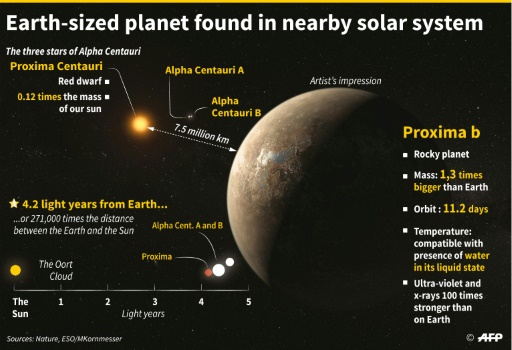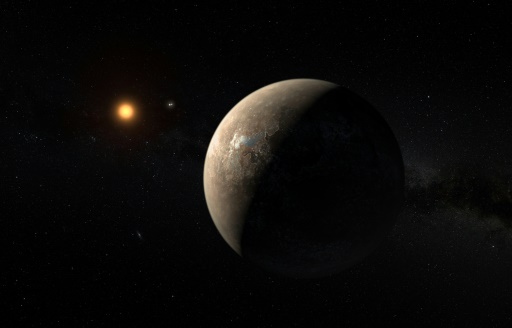Possibility of Oceans on Planet in Closest Star System to Our Sun
A rocky planet discovered in the “habitable” zone of the star nearest our Sun may be covered with oceans, researchers at France’s CNRS research institute said Thursday.
A team including CNRS astrophysicists have calculated the size and surface properties of the planet dubbed Proxima b, and concluded it may be an “ocean planet” similar to Earth.Scientists announced Proxima b’s discovery in August, and said it may be the first exoplanet—planet outside our Solar System—to one day be visited by robots from Earth.The planet orbits within a “temperate” zone from its host star Proxima Centauri, some four light years from us.It is estimated to have a mass about 1.3 times that of Earth, and orbits about 7.5 million kilometres (4.6 million miles) from its star—about a tenth the distance of innermost planet Mercury from the Sun.
“Contrary to what one might expect, such proximity does not necessarily mean that Proxima b’s surface is too hot” for water to exist in liquid form, said a CNRS statement.Proxima Centauri is smaller and 1,000 times weaker than our Sun, which means Proxima b is at exactly the right distance for conditions to be potentially habitable.”The planet may very well host liquid water on its surface, and therefore also some forms of life,” the statement said.

The exoplanets’ sizes are typically determined by measuring the amount of light they obstruct when passing in front of their host star, as observed from Earth. However, no such transit of Proxima b has been witnessed yet. Therefore, the team had to rely on simulations to estimate the planet’s radius and composition.Based on their calculations, the radius of Proxima b falls between 0.94 and 1.4 times that of Earth, which has an average radius of 6,371 kilometers. Assuming a minimum radius of 5,990 km, the planet would possess a high density, with a metallic core constituting two-thirds of its total mass, surrounded by a rocky mantle.
If there is surface water on Proxima b, it would contribute no more than 0.05 percent to the planet’s overall mass, similar to Earth where it accounts for approximately 0.02 percent.In the case of a larger planet with a radius of 8,920 km, Proxima b’s mass would be evenly divided between a rocky core and surrounding water, with a 50-50 split.According to the CNRS, “In this scenario, Proxima b would be enveloped by a single, liquid ocean that is 200 km deep.”
Regardless of the specific scenario, both cases suggest that Proxima b could potentially be habitable, as it could possess a thin, gaseous atmosphere similar to Earth.
This article is republished from PhysORG under a Creative Commons license. Read the original article.
Do not forget to share your opinion with us to provide you with the best posts !




0 Comments